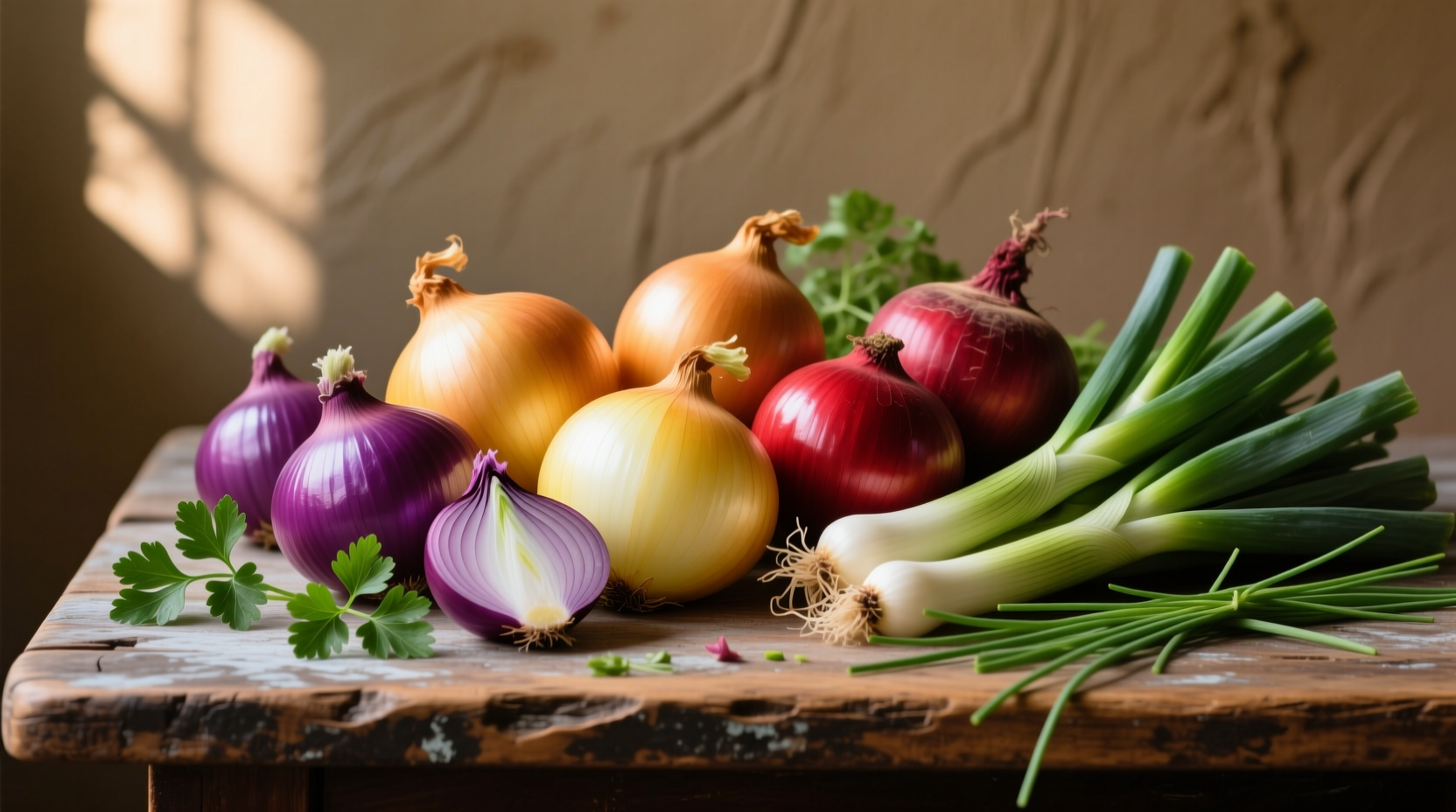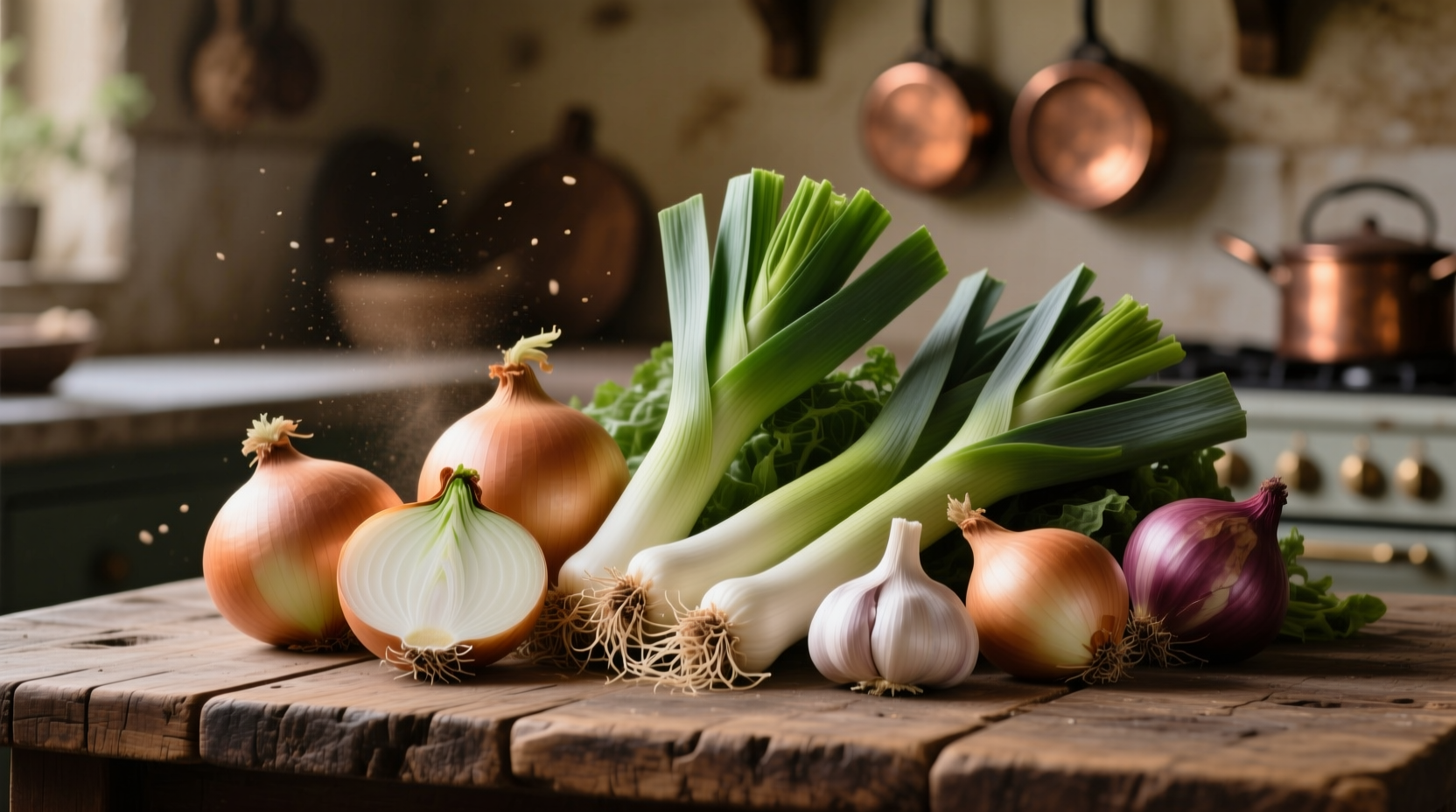The onion family (Allium genus) includes garlic, onions, leeks, chives, and shallots—nutrient-dense vegetables packed with antioxidants, sulfur compounds, and vitamins C and B6. These vegetables reduce inflammation, support heart health, and may lower cancer risk, with just one medium onion providing 20% of your daily vitamin C needs according to USDA data.
Understanding the diverse members of the onion family transforms how you approach cooking, gardening, and nutrition. These versatile vegetables form the flavor foundation of cuisines worldwide while delivering science-backed health benefits. Whether you're a home cook seeking better techniques or a health-conscious eater exploring functional foods, knowing how to maximize these ingredients elevates your results.
What Defines the Onion Family Botanically
The Allium genus encompasses over 850 species of bulbous plants characterized by their distinctive sulfur-containing compounds that create pungent aromas and flavors when cut or crushed. These biennial plants share common structural features including underground bulbs, hollow leaves, and flower clusters forming spherical umbels. The characteristic 'onion breath' comes from allicin, a compound formed when enzymes react with alliin after cellular damage occurs—a natural defense mechanism evolved over millennia.
| Vegetable | Key Compounds | Vitamin C (per 100g) | Unique Properties |
|---|---|---|---|
| Garlic | Allicin, Ajoene | 31.2mg | Antimicrobial, cardiovascular support |
| Yellow Onion | Quercetin, Anthocyanins | 7.4mg | High antioxidant content, versatile cooking |
| Leek | Kaempferol, Organosulfides | 12mg | Milder flavor, excellent source of vitamin K |
| Chives | Allyl sulfides | 21mg | Delicate flavor, high vitamin A content |
Data sourced from USDA FoodData Central (2023 release) showing nutritional variations across common Allium vegetables. This comparison helps you select the right variety for specific health goals and culinary applications.
Evolutionary Timeline of Allium Cultivation
Archaeological evidence reveals humans have utilized Allium vegetables for over 5,000 years. Ancient Egyptian records from 3200 BCE document onion cultivation, with workers building the pyramids reportedly consuming them daily for strength. Chinese texts from 2600 BCE mention garlic's medicinal uses, while Greek athletes ate garlic before Olympic competitions for enhanced performance. During the Middle Ages, monasteries preserved Allium cultivation techniques through Europe's dark period. The Columbian Exchange introduced Old World Alliums to the Americas, where native varieties like wild garlic (Allium tricoccum) were already integral to indigenous diets. Modern breeding since the 1950s has developed sweeter onion varieties like Vidalia and Walla Walla through selective cultivation in low-sulfur soils.
Maximizing Health Benefits Through Proper Preparation
The health-promoting compounds in onion family vegetables activate differently based on preparation methods. For garlic, crushing and waiting 10 minutes before heating maximizes allicin production, as shown in a 2017 Journal of Agricultural and Food Chemistry study. Cooking onions slowly caramelizes natural sugars while preserving quercetin, but high-heat frying destroys heat-sensitive compounds. Raw consumption delivers maximum enzyme activity but may cause digestive discomfort for some individuals. Those with irritable bowel syndrome should limit intake of raw Alliums due to high FODMAP content, while cooked versions often remain tolerable.

Culinary Applications Across Global Cuisines
Professional chefs leverage specific Allium varieties to create distinct flavor profiles. French cuisine builds flavor foundations with mirepoix (onions, carrots, celery), while Spanish sofrito uses tomatoes with onions and garlic. In Indian cooking, asafoetida (hing), a resin from Allium tuberosum, provides onion-like flavor for religious dietary restrictions. Japanese scallion pancakes (negiyaki) showcase the subtle sweetness of long-cooked alliums. For home cooks, understanding these regional applications helps recreate authentic flavors: use shallots for delicate French sauces, garlic for Mediterranean dishes, and leeks for creamy soups where milder flavor is preferred.
Growing Your Own Allium Varieties
Gardeners can successfully cultivate multiple Allium types with proper timing. Plant garlic cloves in fall for summer harvest, onions from sets in early spring, and leeks from seed indoors 8-10 weeks before last frost. Alliums prefer well-drained soil with pH 6.0-7.0 and require consistent moisture during bulb formation. Rotate crops annually to prevent soil-borne diseases like white rot. For continuous harvest, plant perennial varieties like Egyptian walking onions that reproduce through top-setting bulbs. Container gardening works well for chives and garlic scapes, requiring only 6-8 inches of soil depth.
Practical Considerations and Limitations
While onion family vegetables offer numerous benefits, certain limitations require awareness. Raw consumption may trigger acid reflux in sensitive individuals, and excessive garlic intake can interact with blood-thinning medications. The sulfur compounds responsible for health benefits also cause temporary breath and body odor—chewing parsley or cardamom seeds helps neutralize these effects. For optimal storage, keep dry onions in cool, dark places (not refrigerated), while green Alliums like scallions last longer when wrapped in damp paper towels in the refrigerator. Understanding these practical boundaries ensures you maximize benefits while minimizing drawbacks.











 浙公网安备
33010002000092号
浙公网安备
33010002000092号 浙B2-20120091-4
浙B2-20120091-4